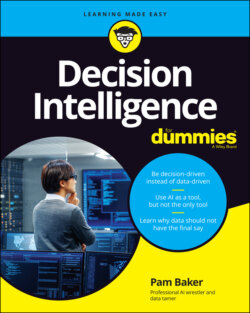Читать книгу Decision Intelligence For Dummies - Pamela Baker - Страница 30
Deputizing AI as Your Faithful Sidekick
ОглавлениеAt its essence, AI automates decisions that are executed rapidly in an exceedingly large number of instances, often simultaneously. You train it by having it work with task-related data sets so that it can recognize what it’s looking at in other data sets and learn from the patterns it finds there. Then it makes decisions based on well-defined business rules. (The reality is a good bit more complicated than that, but that's pretty much the gist of it.)
For example, banking institutions use AI to automatically decide which loan applications to approve and which to reject. This is how you can get an answer on your loan application within seconds, no matter how many other people are applying for loans at the same time you are. AI makes these decisions based on the rules it has been given, such as a range of acceptable credit scores, length and types of employment history, items of public record, and other such risk weighting values. AI is able to make such decisions on each individual application, yet at enormous scale and all of it within seconds or minutes. Therefore, borrowers can receive immediate responses to their applications, and lenders can secure more loan deals in minutes than they previously were able to secure over a period of months and at the larger payroll cost of many manhours.
AI is set to continue to serve in this and other automated roles for the foreseeable future. As a technology, it will continue to improve as all technologies do, but placing it within a decision intelligence framework means that its performance will improve exponentially because it is given not only rules to follow but also a target to aim at. Its tasks will be set upon a path of specific actions necessary for creating a specific business impact, and it will faithfully pound away at these tasks until its model decays or someone makes a new model to create another path leading to another targeted impact.
Other technologies, such as robotic process automation (RPA) and application programming interfaces (APIs), integrate processes. (RPAs are now called virtual workers because they mimic how human workers work, including interacting with user interfaces in the same way.) As RPAs continue to automate processes that were previously difficult to automate, AI can be added to make some automated decisions affecting these processes as well. In other words, the whole of technology engaged in decision making is getting smarter and better and more able to work together.
All this might sound like a setup for a dystopian science fiction movie, but in reality, these developments are nothing to fear. In decision intelligence, whichever technologies you end up using are chosen specifically to augment human soft skills, like creative problem solving, critical thinking, empathy, emotional intelligence, creative design, creative disruption, intuitive intelligence, and intuitive decision making — skills considered nearly impossible to mimic and automate. Even gut instinct can be considered a soft skill, and it too is well out of AI’s reach. What ends up happening in decision intelligence is that all human strengths attributable to good judgment and smart decisions are by necessity added to the mix.
AI is better cast in the role of sidekick, where it augments human decisions rather than dictates or directs them. The same is true of analytics tied to other automated processes as well.
Much of the decision intelligence revolution is happening out of the end user’s line of sight, but there’s one place where anyone can see the changes unfolding: AI digital assistants such as Google Assistant, Alexa, and Siri. Watch closely as they move from giving you facts in response to your questions to making unprompted recommendations based on your behavior and moods.
Fact reporting such as, “Here are pharmacies near you” or “The name of that song is ABC” will begin to shift to customized and unprompted recommendations. They may look and sound something like this: “XYZ Restaurant has added one of your favorite dishes to its menu. Would you like for me to book the opening in the reservation schedule on Thursday at 7pm and put it on your calendar?” Or, it may say something like this: “Would you like for me to place your favorite coffee order for the pickup window? The one a block from your meeting place has less than a 10 minute wait.”
The AI assistant will also produce files for meetings and other handy actions as the user moves through their day. As sidekicks in a user’s personal and professional life, the augmented activities will be far more productive than had the human personally tended to all the details and micro decisions.
In digital decision-making, AI will improve at everything it now does — and then some. For example, it will improve at writing algorithms to rapidly meet an organization’s or researcher’s desired outcomes. That means that, for today and far into the future, AI will be in a position to continue its role as sidekick, producing everything you need to win the day. It’s unimaginable that AI won’t have some role, small or large, in most Decision Intelligence processes.
